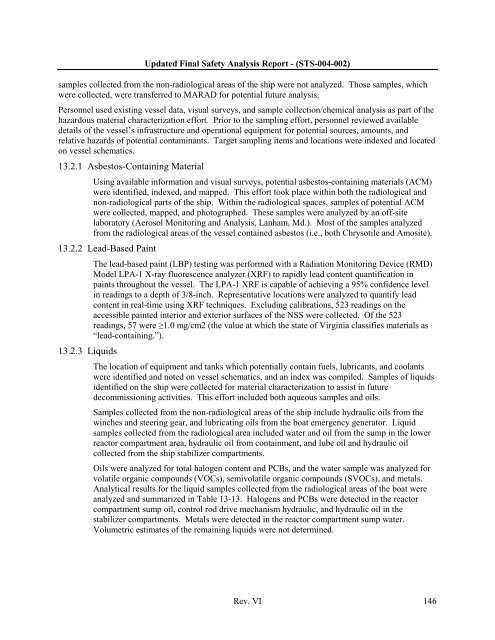10 CFR 50.71(e) - Maritime Administration - U.S. Department of ...
10 CFR 50.71(e) - Maritime Administration - U.S. Department of ...
10 CFR 50.71(e) - Maritime Administration - U.S. Department of ...
You also want an ePaper? Increase the reach of your titles
YUMPU automatically turns print PDFs into web optimized ePapers that Google loves.
Updated Final Safety Analysis Report - (STS-004-002)samples collected from the non-radiological areas <strong>of</strong> the ship were not analyzed. Those samples, whichwere collected, were transferred to MARAD for potential future analysis.Personnel used existing vessel data, visual surveys, and sample collection/chemical analysis as part <strong>of</strong> thehazardous material characterization effort. Prior to the sampling effort, personnel reviewed availabledetails <strong>of</strong> the vessel’s infrastructure and operational equipment for potential sources, amounts, andrelative hazards <strong>of</strong> potential contaminants. Target sampling items and locations were indexed and locatedon vessel schematics.13.2.1 Asbestos-Containing MaterialUsing available information and visual surveys, potential asbestos-containing materials (ACM)were identified, indexed, and mapped. This effort took place within both the radiological andnon-radiological parts <strong>of</strong> the ship. Within the radiological spaces, samples <strong>of</strong> potential ACMwere collected, mapped, and photographed. These samples were analyzed by an <strong>of</strong>f-sitelaboratory (Aerosol Monitoring and Analysis, Lanham, Md.). Most <strong>of</strong> the samples analyzedfrom the radiological areas <strong>of</strong> the vessel contained asbestos (i.e., both Chrysotile and Amosite).13.2.2 Lead-Based Paint13.2.3 LiquidsThe lead-based paint (LBP) testing was performed with a Radiation Monitoring Device (RMD)Model LPA-1 X-ray fluorescence analyzer (XRF) to rapidly lead content quantification inpaints throughout the vessel. The LPA-1 XRF is capable <strong>of</strong> achieving a 95% confidence levelin readings to a depth <strong>of</strong> 3/8-inch. Representative locations were analyzed to quantify leadcontent in real-time using XRF techniques. Excluding calibrations, 523 readings on theaccessible painted interior and exterior surfaces <strong>of</strong> the NSS were collected. Of the 523readings, 57 were ≥1.0 mg/cm2 (the value at which the state <strong>of</strong> Virginia classifies materials as“lead-containing.”).The location <strong>of</strong> equipment and tanks which potentially contain fuels, lubricants, and coolantswere identified and noted on vessel schematics, and an index was compiled. Samples <strong>of</strong> liquidsidentified on the ship were collected for material characterization to assist in futuredecommissioning activities. This effort included both aqueous samples and oils.Samples collected from the non-radiological areas <strong>of</strong> the ship include hydraulic oils from thewinches and steering gear, and lubricating oils from the boat emergency generator. Liquidsamples collected from the radiological area included water and oil from the sump in the lowerreactor compartment area, hydraulic oil from containment, and lube oil and hydraulic oilcollected from the ship stabilizer compartments.Oils were analyzed for total halogen content and PCBs, and the water sample was analyzed forvolatile organic compounds (VOCs), semivolatile organic compounds (SVOCs), and metals.Analytical results for the liquid samples collected from the radiological areas <strong>of</strong> the boat wereanalyzed and summarized in Table 13-13. Halogens and PCBs were detected in the reactorcompartment sump oil, control rod drive mechanism hydraulic, and hydraulic oil in thestabilizer compartments. Metals were detected in the reactor compartment sump water.Volumetric estimates <strong>of</strong> the remaining liquids were not determined.Rev. VI 146
















